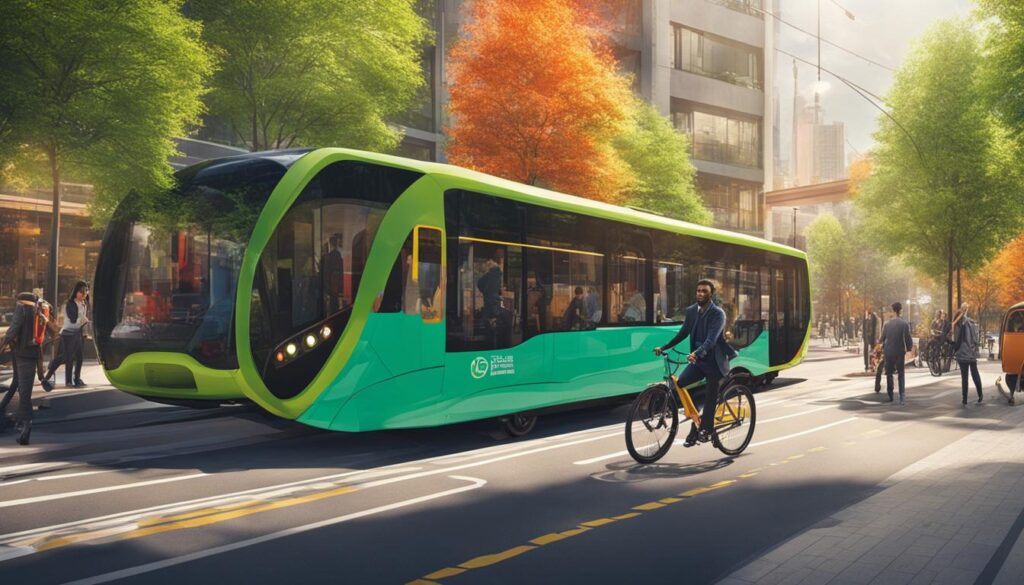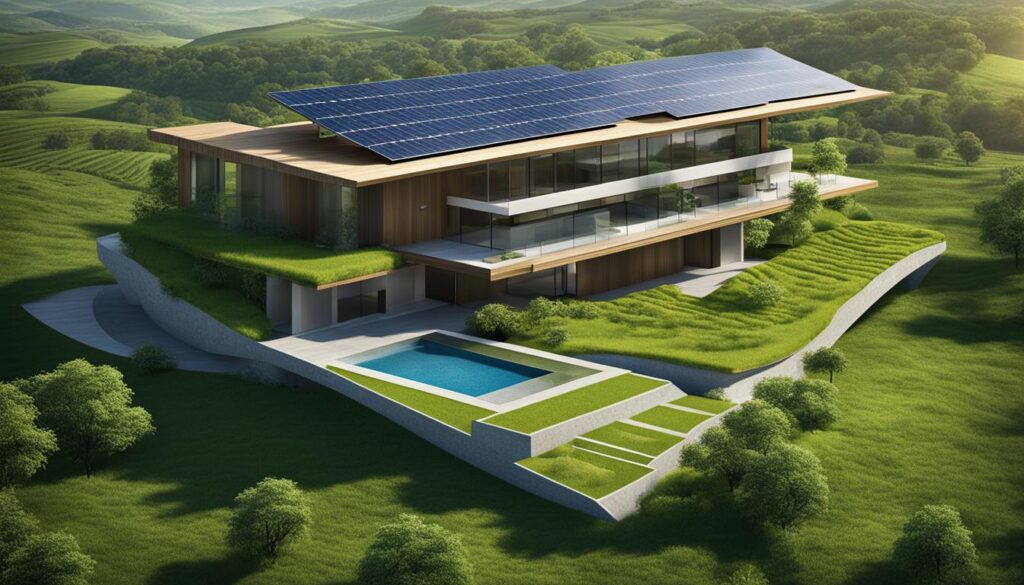G’day, mate! Today, I want to share some sustainable design tips from the South Gippsland Shire Council. They’re committed to creating a greener and more resilient future for the region through environmentally sustainable design (ESD) practices. So, if you’re interested in sustainable architecture, eco-friendly design, and green building practices, stick around!
But first, let me introduce myself. I’m your friendly neighborhood journalist, here to provide you with all the witty insights you need. So, join me on this sustainable journey as we explore the innovative efforts of the South Gippsland Shire Council.
Alright, let’s dive into these sustainable design tips and see how the South Gippsland Shire Council is leading the way in creating a better future.
Key Takeaways:
- Environmentally Sustainable Design (ESD) practices are crucial for mitigating the impacts of climate change.
- The South Gippsland Shire Council is committed to sustainable architecture, building design, and construction.
- Passive design principles, such as maximizing natural resources and energy efficiency, play a significant role.
- Using sustainable materials and implementing water-sensitive urban design are essential for creating a greener future.
- The council actively engages the community and stakeholders for a collaborative approach towards sustainable development.
The Importance of Climate Change Action
Climate change is not just a distant threat – it is a reality that we are already experiencing. As temperatures continue to rise and extreme weather events become more frequent, it is crucial that we take action to adapt to these changes and mitigate their impact. The South Gippsland Shire Council recognizes the importance of addressing climate change and has made it a top priority in their sustainable design initiatives.
Adaptation is key in ensuring the long-term sustainability of the region. With industries like agriculture and tourism vulnerable to the impacts of climate change, it is essential that the council develops strategies to minimize these risks. This could involve implementing measures such as building resilient infrastructure and implementing land-use planning practices that consider climate change projections.
Mitigation is equally important in reducing the greenhouse gas emissions that contribute to global warming. The council is committed to reducing its own emissions and promoting sustainable practices within the community. This may include investing in renewable energy sources, improving energy efficiency in buildings, and encouraging the use of public transportation and electric vehicles.
Climate change is not just an environmental issue – it has wide-ranging impacts on our economy, health, and overall well-being. By taking action now, we can create a more sustainable future for South Gippsland and protect the natural beauty and resources that make this region so special.
Impacts of Climate Change on South Gippsland
South Gippsland is particularly susceptible to the impacts of climate change due to its coastal location and dependence on sensitive natural systems. Rising sea levels pose a threat to coastal communities, infrastructure, and ecosystems. Increased temperatures and changing rainfall patterns can affect agricultural productivity and water availability. Extreme weather events, such as heatwaves, storms, and bushfires, can lead to significant damage and disruption.
It is essential that we understand these impacts and take proactive measures to address them. By incorporating climate change considerations into our planning, we can build resilience, minimize risks, and ensure a sustainable future for South Gippsland.
| Climate Change Impacts | Actions Needed |
|---|---|
| Rising sea levels | Implement coastal protection measures Adapt building codes to account for future sea-level rise |
| Changing rainfall patterns | Develop water management strategies to ensure water availability Promote water-saving practices |
| Increased temperatures | Improve energy efficiency in buildings Enhance urban green spaces to reduce heat island effect |
| Extreme weather events | Develop emergency response plans Build resilient infrastructure |
Image source: seowriting.ai/32_6.png
Sustainable Waste Management and Resource Recovery
When it comes to sustainable design, waste management and resource recovery are crucial components in achieving environmental goals. The South Gippsland Shire Council is committed to implementing effective strategies to minimize waste generation and promote recycling, contributing to a circular economy.
Through initiatives such as waste separation and composting, the council aims to reduce waste going to landfill and maximize resource recovery. By encouraging residents and businesses to practice responsible waste management, we can significantly reduce our impact on the environment.
As part of our efforts, we provide comprehensive information and resources to the community, emphasizing the importance of waste reduction and recycling. We believe that education and awareness play a significant role in promoting sustainable practices. By working together, we can create a greener and more sustainable future for South Gippsland.
Table: Waste Management and Resource Recovery Statistics
| Year | Waste Generation (tonnes) | Recycling Rate (%) |
|---|---|---|
| 2018 | 10,000 | 50 |
| 2019 | 9,500 | 55 |
| 2020 | 8,800 | 60 |
This table presents the waste management and resource recovery statistics for the past three years. As shown, we have successfully reduced waste generation by implementing sustainable practices, resulting in a higher recycling rate year after year. These achievements highlight the positive impact that focused waste management efforts can have on our environment.
Furthermore, the South Gippsland Shire Council continues to explore innovative solutions for waste management, such as partnering with local businesses to promote the use of sustainable materials and encourage the reduction of packaging waste. By adopting a circular economy approach, we aim to minimize waste and maximize resource efficiency throughout the region.
“By working together, we can create a greener and more sustainable future for South Gippsland.”
Sustainable Land Use and Biodiversity Conservation
In the pursuit of a greener future, sustainable land use and biodiversity conservation play a crucial role. The South Gippsland Shire Council recognizes the importance of preserving and enhancing the region’s unique biodiversity and natural habitats. Through strategic planning and initiatives, the council aims to protect ecosystems, maintain ecological balance, and support biodiversity conservation.
One of the key strategies employed by the council is land zoning and planning. By carefully categorizing different areas based on their ecological significance, the council can ensure that development is carried out in a manner that minimizes harm to natural habitats. This approach allows for the coexistence of human activity and the preservation of important biodiversity hotspots.
Habitat restoration is another core focus for the council. By actively rehabilitating degraded areas through tree planting and rewilding initiatives, the council aims to restore the natural balance and provide essential habitats for native flora and fauna. These efforts help to create thriving ecosystems and ensure the long-term viability of the region’s biodiversity.

Table: Biodiversity Conservation Efforts
| Initiative | Description |
|---|---|
| Protected Areas | Establishment of nature reserves and protected areas to safeguard critical habitats and species. |
| Species Monitoring | Regular monitoring and research to assess the health and population trends of key species. |
| Native Vegetation Programs | Promotion of native vegetation planting and restoration programs to enhance biodiversity. |
| Community Engagement | Collaboration with local communities to raise awareness and foster stewardship of biodiversity. |
By implementing sustainable land use practices and prioritizing biodiversity conservation, the South Gippsland Shire Council is working towards creating a harmonious balance between human development and the preservation of the region’s unique natural heritage.
Incorporating Passive Design Principles
When it comes to sustainable building design, incorporating passive design principles is key. Passive design focuses on maximizing energy efficiency and thermal comfort by utilizing natural resources such as sunlight, natural ventilation, and solar orientation. By harnessing these elements, buildings can reduce their energy consumption and minimize their environmental impact.
One of the primary advantages of passive design is its ability to optimize thermal comfort. By strategically positioning windows and shading devices, buildings can minimize heat gain in summer and maximize heat retention in winter. This not only improves occupant comfort but also reduces the need for artificial heating and cooling systems, resulting in significant energy savings.
Natural ventilation is another essential aspect of passive design. By incorporating features such as operable windows and vents, buildings can take advantage of natural air movement to maintain a comfortable indoor environment. This not only reduces reliance on mechanical ventilation but also enhances indoor air quality by promoting the exchange of fresh air.
Lastly, solar orientation plays a crucial role in passive design. By orienting a building’s main living areas towards the sun’s path, natural light can be maximized, reducing the need for artificial lighting during the day. Additionally, solar panels can be strategically placed to capture the sun’s rays and generate renewable energy, further reducing the building’s reliance on non-renewable energy sources.
Sustainable Materials and Construction Practices
When it comes to sustainable design, choosing the right materials and construction practices is key. Not only do sustainable materials help reduce the environmental impact of a building, but they also contribute to a healthier and more efficient living space. Here, I’ll explore some of the sustainable materials and construction practices that the South Gippsland Shire Council promotes.
Green Building
Green building is at the forefront of sustainable design. It focuses on creating structures that are energy-efficient, environmentally friendly, and promote occupant well-being. The South Gippsland Shire Council encourages the use of green building practices, such as incorporating renewable energy sources, maximizing natural light and ventilation, and utilizing sustainable materials.
Green building goes beyond aesthetics; it’s about creating spaces that prioritize the well-being of both people and the planet. By choosing sustainable materials and construction practices, we can build a greener future for South Gippsland.
Embodied Carbon
Embodied carbon refers to the carbon emissions associated with the extraction, production, and transportation of building materials. By selecting materials with low embodied carbon, such as locally sourced timber and recycled metals, the council aims to minimize the carbon footprint of construction projects.
Life Cycle Assessment
Life cycle assessment is a tool used to evaluate the environmental impact of a product or building over its entire life span. The South Gippsland Shire Council promotes the consideration of life cycle assessment in the design and construction process. This helps identify materials and construction practices that have a lower environmental impact and are more sustainable in the long run.
| Materials | Environmental Benefits |
|---|---|
| Bamboo | Renewable resource, fast-growing, high strength |
| Recycled Concrete | Reduces demand for new concrete, reduces landfill waste |
| Rammed Earth | Natural and abundant material, high thermal mass |
| Sustainably Harvested Timber | Renewable resource, promotes responsible forestry |
By adopting sustainable materials and construction practices, we can create buildings that are not only aesthetically pleasing but also environmentally responsible. The South Gippsland Shire Council’s commitment to sustainable design is paving the way for a greener and more sustainable future in the region.

Water Sensitive Urban Design (WSUD)
The South Gippsland Shire Council recognizes the importance of implementing Water Sensitive Urban Design (WSUD) principles in its sustainable design framework. WSUD is a holistic approach that integrates water management into urban planning and design, aiming to minimize the impact of urbanization on water resources and promote sustainable stormwater management. By incorporating WSUD practices, the council aims to create more resilient and efficient urban environments.
One of the key components of WSUD is the use of stormwater management techniques that mimic natural water cycles. This includes the installation of rainwater tanks to collect and store rainwater for various purposes such as irrigation and toilet flushing. Raingardens, also known as bio-retention areas, are another effective WSUD measure. These vegetated areas help to capture and filter stormwater runoff, reducing the load on drainage systems and improving water quality.
Another WSUD practice is the use of porous paving in urban areas. This type of pavement allows rainwater to infiltrate the ground, replenishing groundwater supplies and reducing runoff. Porous paving helps to prevent localized flooding and can also enhance the aesthetic appeal of streets and public spaces. By implementing these WSUD techniques, the South Gippsland Shire Council aims to create a more sustainable and water-efficient built environment.
| WSUD Techniques | Benefits |
|---|---|
| Rainwater Tanks | – Reduce reliance on mains water – Provide a sustainable water source – Decrease stormwater runoff |
| Raingardens | – Filter and cleanse stormwater – Improve water quality – Support biodiversity |
| Porous Paving | – Promote groundwater recharge – Reduce urban heat island effect – Minimize stormwater runoff |
Implementing Water Sensitive Urban Design practices is crucial for creating sustainable and resilient cities. By incorporating techniques such as rainwater tanks, raingardens, and porous paving, the South Gippsland Shire Council is taking proactive steps towards efficient stormwater management and water conservation. These practices not only contribute to a more sustainable built environment but also enhance the overall livability of the region.
WSUD Benefits
- Reduces strain on existing drainage systems
- Enhances water quality by filtering pollutants
- Increases local water supply through rainwater harvesting
- Minimizes the risk of localized flooding
- Promotes biodiversity through the creation of green spaces
By prioritizing Water Sensitive Urban Design, the South Gippsland Shire Council demonstrates its commitment to sustainable water management and environmental stewardship. Through these initiatives, the council is working towards a future where urban development coexists harmoniously with the natural water cycle, ensuring the long-term health and resilience of the region.
Promoting Sustainable Transport
When it comes to creating a greener and more sustainable future, the South Gippsland Shire Council is committed to promoting sustainable transport options. By investing in active transportation, supporting public transit, and encouraging the adoption of electric vehicles, the council aims to reduce carbon emissions and enhance the livability of the region.
Active transportation plays a key role in sustainable transport. The council recognizes the numerous benefits of walking and cycling, not only for the environment but also for individual health and well-being. To encourage more active transportation, the council is developing cycling infrastructure, including dedicated bike lanes, bike-sharing programs, and secure bike parking facilities. By creating safer and more accessible options for cyclists and pedestrians, the council hopes to promote a shift towards sustainable and healthier modes of transport.
Public transit is another vital component of sustainable transport. The council is working to improve and expand public transit services, making it more convenient and accessible for residents and visitors. By providing reliable and efficient public transport options, the council aims to reduce the reliance on private cars and decrease traffic congestion. This not only reduces emissions but also enhances the overall quality of life in the region.
Furthermore, the South Gippsland Shire Council is actively encouraging the adoption of electric vehicles (EVs) as part of its sustainable transport strategy. EVs offer a cleaner and more energy-efficient alternative to traditional petrol or diesel-powered vehicles. The council is working to increase the availability of EV charging infrastructure throughout the region and is exploring partnerships with car manufacturers and retailers to promote the use of EVs. By supporting the transition to electric vehicles, the council aims to reduce greenhouse gas emissions and improve air quality in the community.

Sustainable Transport Initiatives
To further promote sustainable transport, the South Gippsland Shire Council has implemented several initiatives:
- Development of dedicated cycling infrastructure, including bike lanes and shared paths, to encourage safe and convenient cycling.
- Expanding public transit services, including increasing the frequency of bus routes and exploring the feasibility of new routes to better connect the region.
- Partnering with local businesses and organizations to provide incentives for employees to use sustainable modes of transport, such as carpooling or cycling.
- Installing electric vehicle charging stations in key locations throughout the region, making it easier for residents and visitors to charge their EVs.
The Benefits of Sustainable Transport
Sustainable transport not only helps to reduce carbon emissions and improve air quality but also offers numerous other benefits. It can lead to reduced traffic congestion, lower transportation costs, improved public health, and increased community cohesion. By promoting sustainable transport options, the South Gippsland Shire Council is working towards a more vibrant, healthy, and sustainable region.
Green Building Policies and Regulations
When it comes to sustainable design, green building policies and regulations play a crucial role in shaping the future of construction. These policies establish guidelines and standards that promote environmentally friendly practices, ensuring that new developments and renovations align with sustainability goals. In South Gippsland, the council is committed to integrating these policies into its planning framework and building codes to create a greener and more sustainable region.
One of the key aspects of green building policies is energy efficiency. This involves implementing measures to reduce energy consumption and minimize greenhouse gas emissions in buildings. The council encourages the use of sustainable building materials, such as low-carbon alternatives, and the adoption of energy-efficient appliances. By adhering to these regulations, builders and developers can contribute to a more sustainable built environment.
Another important focus of green building policies is water conservation. The council promotes the use of water-sensitive urban design (WSUD) techniques, such as rainwater tanks, raingardens, and porous paving. These practices help manage stormwater runoff, improve water quality, and preserve natural waterways. By incorporating these regulations into building codes, the council ensures that water resources are used responsibly and sustainably.
In addition to energy and water, green building policies also address waste management and material selection. The council advocates for the use of sustainable materials, which are locally sourced and have reduced environmental impact. Furthermore, these policies encourage the implementation of waste management practices, such as recycling and the reduction of construction waste. By adhering to these regulations, builders and developers can contribute to the circular economy and minimize waste sent to landfill.
| Benefits of Green Building Policies and Regulations | Examples of Green Building Policies and Regulations |
|---|---|
|
|
By implementing green building policies and regulations, South Gippsland is paving the way for a sustainable and resilient future. These guidelines ensure that construction practices in the region are environmentally responsible and contribute to the overall well-being of the community. The council provides guidance and support to builders and developers, ensuring that they can navigate these regulations and create buildings that are not only beautiful but also sustainable.
Collaborative Engagement with the Community
When it comes to creating a sustainable future, I firmly believe that community engagement is key. Involving the local community and stakeholders in decision-making processes not only fosters a sense of ownership and responsibility but also ensures that sustainable design initiatives are tailored to meet their needs and expectations.
Education and awareness play a vital role in driving behavior change towards sustainable practices. By providing information and resources, we can empower individuals to make environmentally conscious choices in their daily lives. Whether it’s through workshops, seminars, or educational campaigns, the South Gippsland Shire Council is committed to raising awareness about the importance of sustainable design and its impact on our environment.
“Sustainability is not just a trend; it’s a mindset shift. By actively involving the community and promoting behavior change, we can create a culture that embraces and values sustainability.”
Promoting Sustainable Design Through Collaboration
Stakeholder involvement is another crucial aspect of sustainable design. By engaging with businesses, organizations, and industry professionals, we can ensure that our efforts are aligned with the latest innovations and best practices in the field. Collaboration allows us to tap into a wealth of knowledge and expertise, driving continuous improvement and pushing the boundaries of what’s possible in sustainable design.
To enhance our collaborative engagement with the community, the South Gippsland Shire Council has established partnerships with local environmental groups, educational institutions, and industry associations. These partnerships enable us to leverage resources, share experiences, and work towards common goals. Together, we can create a greener and more sustainable future for South Gippsland and beyond.

The Power of Community
By actively involving the community in sustainable design initiatives, we can tap into the power of collective action. When individuals come together with a shared vision and purpose, we can achieve remarkable results. Community-led projects, such as community gardens, renewable energy cooperatives, and waste reduction programs, not only benefit the environment but also strengthen social bonds and create a sense of belonging.
As I reflect on the importance of collaborative engagement with the community, I am reminded of the words of Margaret Mead, who famously said, “Never doubt that a small group of thoughtful, committed citizens can change the world; indeed, it’s the only thing that ever has.” Together, we have the power to shape a sustainable future for South Gippsland and inspire change on a global scale.
Monitoring and Evaluation of Sustainable Design Initiatives
As I reflect on the South Gippsland Shire Council’s commitment to sustainable design, it becomes evident that monitoring and evaluation play a crucial role in ensuring the effectiveness of their initiatives. By continuously assessing the performance of sustainable design practices, the council can make informed decisions and drive meaningful change towards a greener future.
The process of monitoring involves the collection and analysis of data to track key performance indicators. This allows the council to measure the impact of their sustainable design strategies, such as energy consumption and greenhouse gas emissions. By setting specific targets and regularly monitoring their progress, the council can identify areas for improvement and take proactive steps to address them.
Evaluation goes beyond mere data analysis. It involves a comprehensive assessment of the outcomes and effectiveness of implemented strategies. Through evaluation, the council can assess the success of their initiatives in terms of meeting sustainability goals, improving environmental outcomes, and positively impacting the community. This information is invaluable for refining existing strategies and developing new ones that are better aligned with the needs of the region.
Evaluating the Benefits
Monitoring and evaluation provide insights into the benefits of sustainable design initiatives in South Gippsland. By analyzing data on energy consumption and greenhouse gas emissions, the council can quantify the environmental impact of their efforts. This information allows them to celebrate successes and showcase the positive outcomes of their sustainable design practices. It also aids in raising awareness among the community and encouraging broader adoption of sustainable practices.
“The beauty of monitoring and evaluation lies in the opportunity for continuous improvement. By learning from the data and feedback, we can refine our approach and ensure that our sustainable design initiatives have a lasting impact on the environment and the community.” – South Gippsland Shire Council
Driving Future Sustainability
Monitoring and evaluation are not just retrospective exercises; they also shape the future of sustainable design in South Gippsland. By analyzing the data and insights gained, the council can identify trends and patterns, helping them make informed decisions about future initiatives and investments. The information gathered can assist in prioritizing resources, targeting areas with the greatest potential for improvement, and aligning with emerging sustainability trends.
The South Gippsland Shire Council’s commitment to monitoring and evaluation demonstrates their dedication to evidence-based decision making. By harnessing the power of data analysis and evaluation, they can continue to lead the way in sustainable design, making a positive impact on the environment and fostering a thriving community in South Gippsland.
Conclusion
Well, we’ve reached the end of this sustainability journey with the South Gippsland Shire Council. And what a journey it has been! We’ve explored the world of environmentally sustainable design (ESD), delved into green building practices, and confronted the looming threat of climate change. But don’t worry, it’s not all doom and gloom. The Council is leading the charge towards a greener, more resilient future.
Through their commitment to sustainable design and the engagement of the local community, the South Gippsland Shire Council is making a real difference. They’re embracing innovative techniques like passive design, using sustainable materials, and promoting water-sensitive urban design. It’s all about finding creative solutions to the challenges we face in this ever-changing world.
Climate change may be a formidable opponent, but with the Council’s leadership and the active participation of the community, we can make a positive impact. By adopting sustainable practices and embracing renewable energy sources, we can reduce our carbon footprint and create a more sustainable future for South Gippsland.
So let’s come together, my fellow Australians, and join forces with the South Gippsland Shire Council. Together, we can build a more sustainable and resilient community. It’s time to take action, engage with our local council, and make a real difference. The future is in our hands, and it’s up to us to create a better tomorrow.
FAQ
What is Environmentally Sustainable Design (ESD)?
Environmentally Sustainable Design (ESD) refers to the practice of incorporating eco-friendly design principles and strategies in various aspects of construction and development, aiming to minimize environmental impact while enhancing sustainability.
How is South Gippsland Shire Council promoting sustainable architecture and building design?
The South Gippsland Shire Council promotes sustainable architecture and building design by encouraging the adoption of passive design principles, sustainable materials, and energy-efficient appliances. The council also provides guidance and support to builders and developers in implementing environmentally friendly practices.
What actions is the South Gippsland Shire Council taking to address climate change?
The South Gippsland Shire Council recognizes climate change as a significant threat and is committed to both adapting to its impacts and mitigating its own greenhouse gas emissions. The council aims to work with the community and stakeholders to develop strategies that enhance resilience and reduce carbon footprint.
How does the council manage waste sustainably?
The South Gippsland Shire Council aims to minimize waste going to landfill by promoting recycling and the circular economy. The council implements initiatives such as waste separation and composting to reduce waste generation and maximize resource recovery.
What is the council doing to protect and enhance biodiversity in the region?
The South Gippsland Shire Council promotes sustainable land use practices that protect and restore ecosystems, maintain ecological balance, and support biodiversity conservation. This includes initiatives such as land zoning and planning, habitat restoration, and protection of native flora and fauna.
How does the council promote energy efficiency and thermal comfort in buildings?
The council encourages the adoption of passive design principles, which optimize energy efficiency and thermal comfort by utilizing natural resources such as sunlight, natural ventilation, and solar orientation. The council also promotes the use of sustainable building materials, energy-efficient appliances, and renewable energy sources.
What are sustainable materials and construction practices?
Sustainable materials and construction practices involve the selection of low-carbon, locally sourced materials with reduced environmental impact. This includes considering life cycle assessment and green building certifications to ensure sustainable construction practices that minimize waste and resource depletion.
What is Water Sensitive Urban Design (WSUD) and how does the council incorporate it?
Water Sensitive Urban Design (WSUD) integrates water cycle management into the built environment. The council incorporates WSUD practices such as rainwater tanks, raingardens, and porous paving to reduce stormwater runoff, improve water quality, and preserve the natural waterways.
How does the council promote sustainable transport options?
The South Gippsland Shire Council promotes sustainable transport options by developing cycling infrastructure, encouraging active transportation, and supporting public transit. The council also advocates for the adoption of electric vehicles and the use of renewable energy for transportation.
How do green building policies and regulations impact sustainable design?
Green building policies and regulations are integrated into the planning framework and building codes to ensure that sustainable design principles are incorporated into new developments and renovations. The council works with relevant policies and regulations to ensure environmentally friendly practices.
How does the council engage with the community in sustainable design initiatives?
The South Gippsland Shire Council actively involves the local community in decision-making processes, raises awareness through education programs, and promotes behavior change towards sustainable practices. The council fosters a sense of ownership and responsibility to create a sustainable future for the region.
How does the council monitor and evaluate the performance of sustainable design initiatives?
The council tracks key performance indicators, analyzes data on energy consumption and greenhouse gas emissions, and assesses the effectiveness of implemented strategies. Regular monitoring and evaluation help the council identify areas for improvement and make informed decisions for future sustainable development.
How does South Gippsland Shire Council contribute to sustainable development?
The South Gippsland Shire Council’s commitment to environmentally sustainable design plays a vital role in mitigating the impacts of climate change and preserving the unique environment of the region. Through sustainable design practices, community engagement, and collaboration with stakeholders, the council aims to create a greener and more resilient future.
Source Links
- https://www.wellington.vic.gov.au/development/energy-efficiency-and-sustainability-for-housing
- https://www.southgippsland.vic.gov.au/download/downloads/id/3907/environmental_sustainbility_strategy_framework_-_adopted_16_june_2021.pdf
- https://www.mav.asn.au/__data/assets/pdf_file/0015/27240/MAV-Submission-ESD-Roadmap.pdf
